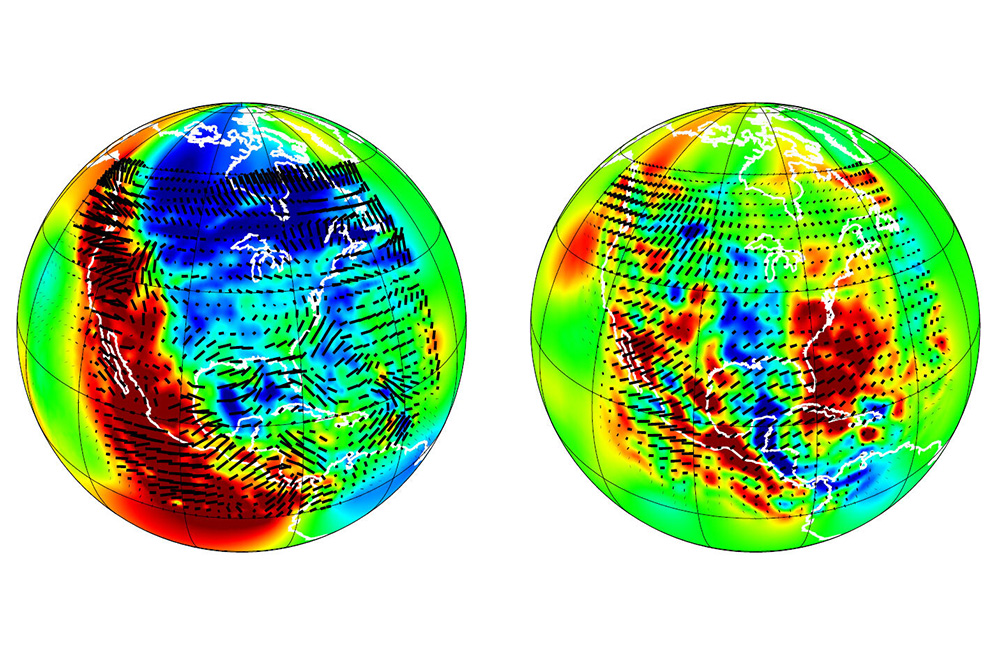Geoscientist Earns CAREER Grant To Study Earth’s Interior
By: Amanda Siegfried | Dec. 3, 2021

A University of Texas at Dallas geoscientist is uncovering new information about the dynamics of the Earth’s interior with the help of a Faculty Early Career Development Program (CAREER) award from the National Science Foundation.
Dr. Hejun Zhu received the five-year, $537,000 award earlier this year to support his research to understand better the physical properties of the mantle, which makes up the bulk of the planet’s interior.
Zhu and his colleagues are studying three major physical seismic properties of the Earth, particularly in North America: seismic wave speed, seismic anisotropy and seismic attenuation.
“To do this, we use a high-resolution, computationally intensive technology that we developed called full waveform inversion, along with high-quality seismic data sets that have been recorded over a 10-year period from earthquakes in the U.S.,” said Zhu, associate professor of geosciences in the School of Natural Sciences and Mathematics.
“As seismologists we can measure quantities such as seismic wave speed, seismic anisotropy and seismic attenuation,” he said. “From these three measurements we can then infer other physical properties like temperature, the presence of water and partial melting of rocks inside the Earth.”

Seismic wave speed describes how fast a mechanical wave generated by an earthquake propagates through the Earth’s interior.
“We know, for example, that the speed of sound waves through the air changes during cold and hot days. That’s similar to what happens inside the Earth,” Zhu said. “Seismic waves travel through cold materials faster than through hot materials. If we are able to investigate wave-speed distributions inside the Earth, we can determine where some regions are colder or hotter than other regions.”
Seismic anisotropy measures the difference in how fast seismic waves travel in different directions inside the Earth. For example, seismic waves traveling north/south might be slightly faster than if they travel east/west. This subtle difference is due to the orientation of certain crystalline minerals in the mantle.
Seismic anisotropy can reveal how the mantle moves around subducting plates. These are portions of the lithosphere — the outer part of the Earth containing the crust and the brittle part of the upper mantle — that are sinking into the warmer mantle.
“By studying these types of subtle differences, we are able to infer information such as past or current deformation inside the planet, and we can also infer movement of materials inside the Earth,” Zhu said.
About CAREER Awards
The Faculty Early Career Development Program supports early-career faculty who exemplify the role of teacher-scholars through outstanding research and excellent education. The highly selective program is the National Science Foundation’s most prestigious award for early-career faculty who are considered likely to become leaders in their fields.
Seismic attenuation is used by seismologists to measure the decay of seismic energy — which is a mechanical energy — over time and distance.
“Seismic attenuation is important, but it is also a poorly understood property of the Earth,” Zhu said. “It allows the mechanical energy of a seismic wave to be converted into heat via the friction of moving rocks. If there was not this type of attenuation, then the mechanical energy generated by an earthquake would bounce back and forth inside the Earth. In other words, the Earth would shake forever, and we’d be in big trouble.”
One focus of Zhu’s research is the mantle transition zone, a region that spans from 250 to 400 miles (410 to 660 kilometers) beneath the Earth’s surface.
“From an earth scientist’s point of view, the Earth is like an onion. You have layers such as the crust, which is a relatively thin skin, and the mantle transition zone, which is a layer that is important for studying convection inside the Earth,” Zhu said.
The Earth’s interior is a heat engine driven by convection, a process that can be likened to a pan of water heating on a stovetop. Hot water rises in the pan, and when it gets to the surface, it cools down. The cold water, which is denser, will sink.
“We have convection inside Earth, with hot mantle material rising from very deep parts of the planet’s interior and pieces of very cold and old oceanic crust, called subduction slabs, sinking into the mantle. Both of these features pass through and interact with the mantle transition zone, so it is very important for us to study this region to better understand the exchange of material inside the planet.”
Combining seismic wave speed, seismic anisotropy and seismic attenuation with Zhu’s full waveform inversion technique allows his research team to develop complex 3D computer models that result in more accurate interpretations of the Earth’s invisible interior.
“The more accurate the information we have, the better our interpretation will be,” he said.
Media Contact:
Amanda Siegfried, UT Dallas, 972-883-4335, amanda.siegfried@utdallas.edu, or the Office of Media Relations, UT Dallas, (972) 883-2155, newscenter@utdallas.edu.





